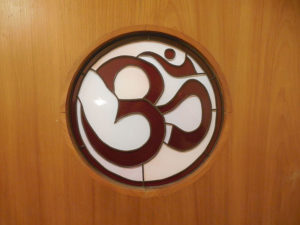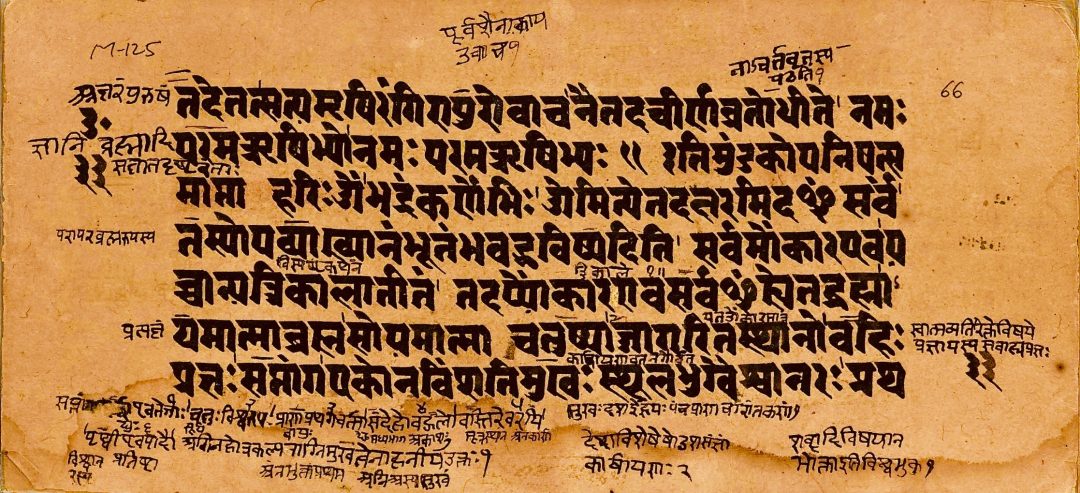Perhaps you’ve chanted the Sanskrit word Aum in meditation (often written Om), or listened to it on a CD. As we Westerners begin to assimilate more of the Eastern symbols and techniques, we should gain a deeper understanding of what they mean. Following is a summary explanation of the Aum syllable as given in the Mandukya Upanishad, a sacred Hindu text from the 7th Century BCE. Generally, the purpose of chanting the Aum is to shift one’s consciousness from ordinary concerns-surviving, eating, and possessing-to ever-expanding or deeper ways of seeing and being.
To diverge for a moment, keep in mind that Hinduism is more than a religion. It is an entire system for living that in more traditional times entered into the whole of East Indian society and culture, offering advice and instruction on such varied topics as cooking, education, and lovemaking, to philosophy, humor, politics, and God. Also, remember that India likes its exploration of philosophy and religion to be primarily psychological in nature and practical in application. That is to say, the big topics in life need to relate immediately to the individual mind and heart, and to every-day life. Having laid that brief foundation, we can now to move to an explanation of the syllable Aum. It can be broken down into three sounds, individually pronounced ah, ooo, and mmm. Each of these sounds is a metaphor for a specific level of consciousness.
When you chant “ah”, only the back of your mouth or throat vibrates. You don’t really feel any vibration in the middle or front of your mouth or in the lips. When chanting “ah” in meditation training, you are instructed to notice this limited vibration and are taught that it is a symbol for waking consciousness. This level of consciousness, perhaps the most prevalent in our lives, is only the tip of the entire iceberg of consciousness. In this state of mind or being, subject and object are separate and different: I see you, you see me-we are not the same, and we interact by relationship. At this level, rational logic and emotional tension prevail. Furthermore, in the realm of everyday waking consciousness, objects and concepts do not shine of themselves. They have to be defined and illuminated from without. Speaking on a religious level, while we are in waking consciousness, we see God as something different and separate from us, and whether on earth or in heaven, we are always in relationship with God. This is the normal worldview of the conventional religious practitioner, regardless of the religion.
Now the chant moves from “ah” to “ooo”. When you shift to the “ooo” syllable, you notice that the vibration moves forward from the back of the throat, filling the majority of the mouth cavity with sound and vibration. The “ooo” syllable is a symbol for dream consciousness, and the suggestion is that because more of the mouth cavity vibrates, we are now dealing with a realm of consciousness more expansive than mere waking consciousness. The dream world is a realm of seemingly infinite possibilities. Many amazing things that would seem impossible in waking life happen effortlessly in your dream life. (I myself have had dreams where I am working through incredibly complex mathematical and scientific formulae, for example. In these dreams, I am amazed at my knowledge, but in the waking world I have nor particular knowledge or ability in math or science).
Unlike the objects of waking consciousness, things in dreams shine of themselves-they are self-luminous. You see physical things and people in your dreams without the advantage of the light. They shine with the light of your mind.
Perhaps the most interesting thing in dream consciousness is that subject and object, which seem to be different, are actually the same. When you dream, you are viewing the dream, just as you watch a movie in a dark theater. But, you are also in the dream, creating the dream-you ARE the dream. The main point is, in dream consciousness, you are two things at once. You are simultaneously the dream and the dreamer. And this is not some lofty notion-it is literally what happens each night that you dream. Therefore, those who are skeptical of the concept of “oneness,” who do not believe that subject and object can be two aspects of one thing, are disproved by what actually happens when one dream. And because of this reality of dream and dreamer being one and the same, your dream life is closer to you, more intimate, than what happens in your waking life.
 Now, speaking on the religious level, though you and whatever god you worship appear separate on the waking consciousness level, on the level of dream consciousness, you began to realize that you and your god are two aspects of the same thing. As the Hindus tell us, all the gods, all the devils, all the heavens, all the hells, are within us. They are not something “out there” that happened somewhere else along time ago. They are manifestations of the enormous depths of consciousness, amazing projections from the ground of being. And though ideas about god differ in description among the various cultures and time periods of history, they are all quite real on a consciousness level, just as the hardness of a rock or coolness of an ice cube is a real consciousness experience.
Now, speaking on the religious level, though you and whatever god you worship appear separate on the waking consciousness level, on the level of dream consciousness, you began to realize that you and your god are two aspects of the same thing. As the Hindus tell us, all the gods, all the devils, all the heavens, all the hells, are within us. They are not something “out there” that happened somewhere else along time ago. They are manifestations of the enormous depths of consciousness, amazing projections from the ground of being. And though ideas about god differ in description among the various cultures and time periods of history, they are all quite real on a consciousness level, just as the hardness of a rock or coolness of an ice cube is a real consciousness experience.
The third syllable in Aum is “mmm”, and when you move from “ooo” to “mmm”, you bring the closing of the lips, creating a vibration of the whole mouth, face, and head. This syllable is a symbol for deep, dreamless sleep consciousness, a realm deeper and larger than dream consciousness. In this state, consciousness is still present, but it is covered over by darkness. This level is completely indiscriminate-a consciousness of no specific thing. There is no active imagination or perception in dreamless sleep. And there is no waking consciousness present either, that would allow you to sense rocks and ice cubes. Life is present in deep dreamless sleep, but there it is also completely free and empty! There is no hate, no love, no pain, no addictions, no ecstasy-everything disappears. What a concept! And yet you are still there, completely alive and absolutely calm. Again, this is not some abstract theory but rather something that literally happens whenever you are having solid sack time.
Now, suppose you could go into deep dreamless sleep while awake.
This is the ultimate purpose of all yoga and meditation training, to be in the realm of pure unfiltered consciousness with no predilections. Here, one has the experience of unified stillness and clarity-exactly the mystical experience interpreted esoterically in many traditions, as demonstrated for example, in Psalms 127:2 of the Judeo-Christian tradition: “God gives truth to his beloved in sleep.” Or it is what the Buddhists call or “Nirvana” or “Ordinary Mind”. (I love that last term!)
There is a fourth aspect of the Aum, the “silence” surrounding it, the break-in sound after you have finished chanting the consonant “mmm” and are taking your next breath. The symbolism behind the silence: While all language has the task of describing and objectifying things, and relationships between things and even the “oneness” of apparently different things, the Ultimate Mystery in Hindu philosophy is not of things. Rather, it is the mysterious void beyond being and non-being that cannot be known or named, from which all tangible and intangible things and forms of consciousness arise, and back into which they go. This is represented by the silence surrounding Aum. And thus Aum is said to be a four-syllable word: ah, ooo, mmm, and silence.






